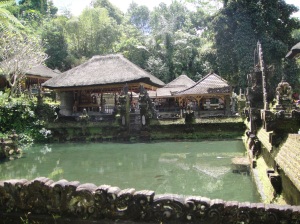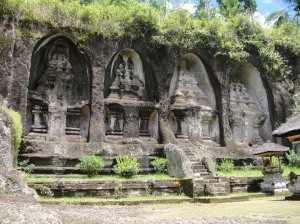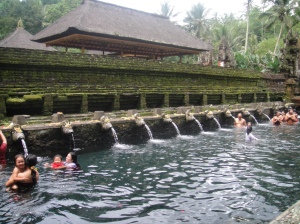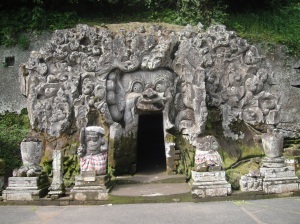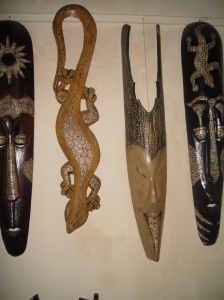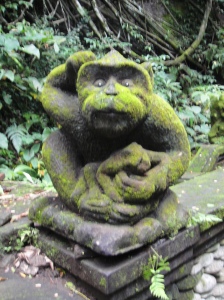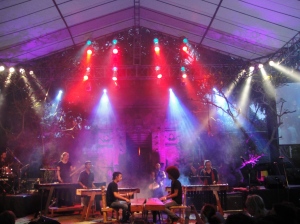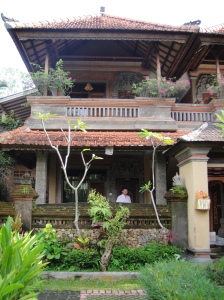We rented a motorbike for the day and headed to see some sights around Ubud.
We wanted to go to see Gunung Kawi – an ancient temple site, which has a group of shines cut into cliff – first, but it proved quite difficult to find. Asking directions from locals who didn’t speak English we ended up at a site called indeed Gunung Kawi, but when we read the descriptions from the LP, it just didn’t seemed to match at all. We then realised that this was another Gunung Kawi (at Sebatu – Tegallalang). That explained the lack of tourist crowds and souvenir stalls around it. It was a nice old temple to see anyway, but we had no idea what was the significance of this particular sight.
The Gunung Kawi of Tampaksiring that we had been looking for was 4 km away. After taking a few more wrong turns, we finally found it. There was a nice small path amidst rice fields leading down to the river. The huge stone engraved shrines were on either sides of the river. The shrines and the temple there date back to 11th century.
From there we moved on to the nearby Tirta Empul – a temple with holy springs, which bubble out from a pool near the temple. The water of the springs is directed to bathing pools. Quite a few locals were paying respect to the spring waters and bathing there. We didn’t feel like joining them for the bath, but still washed our hands and faces with refreshing spring water.
We then headed back towards Ubud, planning to see a few more sights highlighted by the LP. With a little more help from locals, we managed to find the Yeh Pulu bas-relief. This is a 25 metre-long carved cliff face, which is believed to date back to 14th century. Compared with the carvings of Borobudur, this is hardly remarkable, but it was quite nice and secluded.
As a final sight, we went to see yet another temple, Goh Gajah – a cave temple carved into a rock with entrance through mouth of a demon. There are also a fountains and a bathing pool around. This temple site is believed to date back to the 11th century.
Once done with the planned temple sightseeing, we rode through the wood carvers villages north of Ubud. The sides of the road had a myriad of workshops selling marvellous future, decorations, small and big figures, masks, etc. In addition, there were a lot of nice shops with excellent choice of lamps. Having endured the almost epic quest for decent lamps for our home, we felt really sad this kind of stuff is not imported into Estonia. We really felt restrained – there is no way we can send any of the lamps, chairs or tables home without spending a fortune on shipping costs, even though the prices for the beautiful things were really reasonable (not to say very cheap).
We got back to our guesthouse right before it got dark. We took advantage of our guesthouse having a swimming pool and after the refreshing splash we capped the day with a quiet dinner.
